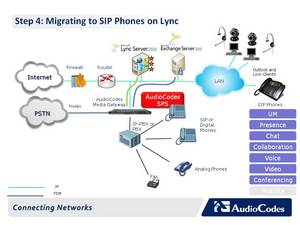Adding SIP Phones
 At this point, we’ve addressed voicemail via Exchange, IM, presence and collaboration and voice and video, and structured your client’s network for the new converged workload through the first three steps of our journey towards complete unified communications.
At this point, we’ve addressed voicemail via Exchange, IM, presence and collaboration and voice and video, and structured your client’s network for the new converged workload through the first three steps of our journey towards complete unified communications.
You may notice that we haven’t touched phones yet. Now, with the trunk line connected to the AudioCodes Mediant media gateway, it’s a good time to think about phones. Because although the hype around unified communications is all about communicating via softphones and using just about any device an end user wants to use to stay connected --- there are still are a lot of people that want to or have to use a phone, whether it’s some of the time or all of the time.
Fortunately, that’s easy enough to do.
Now, we’d love it if every customer were to rip and replace their existing phones with brand new SIP phones. And we’d especially love it if they’d do so with our AudioCodes 320HD IP Phones. Moving to the 320HD or another Lync-certified SIP phone would offer the most functionality for end users, the best overall experience, and the most profitability for you.
But in a lot of cases, that may not be realistic. Sometimes a customer has made a significant (and recent!) investment in SIP phones and isn’t ready to rip and replace quite yet. Or maybe they’re concerned about sending more lightly used technology to the landfill.
Whatever their motivation for hanging onto their existing SIP phones, you’re covered. Audiocodes’ SIP Phone Server (SPS) software is available as either a stand-alone server appliance or an OSN module for your gateway, and can connect a wide array of SIP-based phones with Microsoft Lync, making the transition easier and less expensive for customers.
So however your customers want to proceed to SIP phones connected to Microsoft Lync, you can make sure they’re getting up and running.
“But wait a second,” I hear you say. “That’s all fine and good for customers who existing SIP-based phones. But what about other legacy phone systems that aren’t SIP-based?” We’ve got a solution for that, and we’ll bring it to you in the next step.
This is really starting to look like a true unified communications system. In terms of effort, the biggest steps are behind us, but there are still four important steps for getting to go. In our next step, we’ll make the transition to unified communications all that much more complete by starting to move customers fully off their legacy PBX.
Continue to Step 5 >>

-thumb-autox90-10361.jpg)






Leave a comment